[ad_1]
These days, I have been excitedly speaking about “composability” as a key new development in martech (and company engineering in basic). But in the absence of defining it more exactly, the time period has triggered some confusion and discussion about what is or is not technically possible currently.
So let’s rectify that.
In the most wide perception, composability is only the capability to blend matters collectively. This may well be knowledge, for occasion, if you want to evaluate products and solutions (a single dataset) that have been marketed to prospects (another dataset). Or it may possibly be ways in a workflow, app, or purchaser working experience — e.g., when a prospect fills out a kind, include or update them in your CRM and e-mail them the report they asked for.
So, wait around, this does not audio pretty new. Have not persons been doing that for a long time?
Sure! If we glance at this spectrum of composability that I’ve sketched — I’ll make clear it in far more element in a moment — some techniques of composing issues together have been close to for ages.
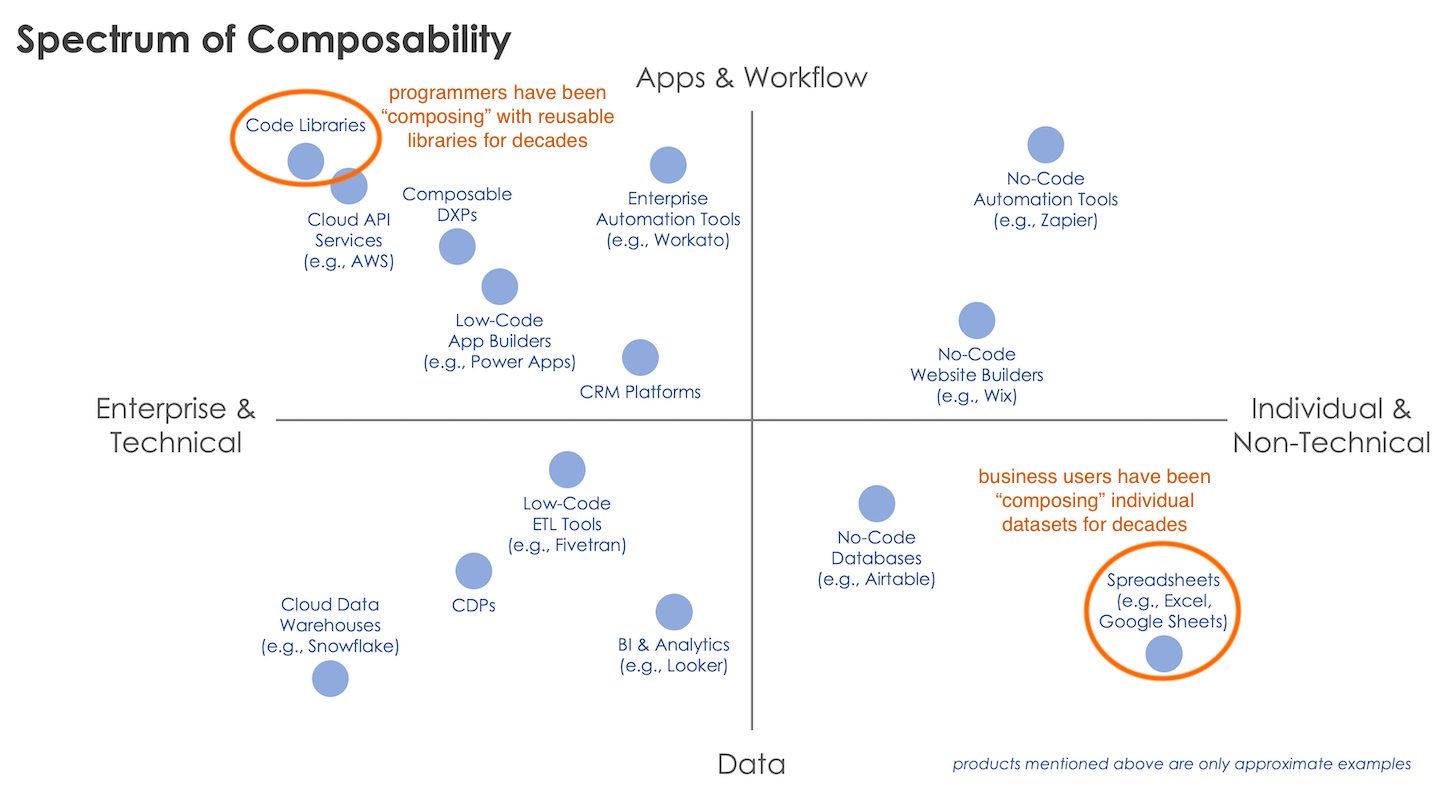
Spreadsheets are likely the oldest “no-code” instrument for business enterprise people to “compose” info assessment by combining different lumps of details collectively on a sheet — or, much more ambitiously, in a workbook — where by they could manipulate them into some thing insightful. Traditionally, most of those people lumps of details have been both manually typed in by the person or imported from a CSV file. Not particularly condition-of-the-art info pipelining. But powerful. Marketers have gotten a ton of mileage out of Excel and Google Sheets.
On the extra specialized close of the spectrum, programmers have been “composing” applications by employing packaged functionality from reusable libraries for the past fifty percent century. The ideas of encapsulation, modularity, and reusability have been foundational to the willpower of software package engineering. No developer writes everything from scratch. They pull in current libraries — Python has more than 400,000 these kinds of offers — or API products and services in the cloud from AWS, Azure, or Google Cloud to assemble an application. They stand on the shoulders of other individuals who came ahead of them and test to only insert web new performance or the logic of how these pieces fit collectively for a specific goal.
Trading granularity/flexibility vs. guardrails/security
I keep placing “composability” in estimates higher than mainly because although spreadsheets and software program libraries are applied for composing points, the much more present day notion of composability seeks to bend the trade-offs involving these two reverse ends of the spectrum.
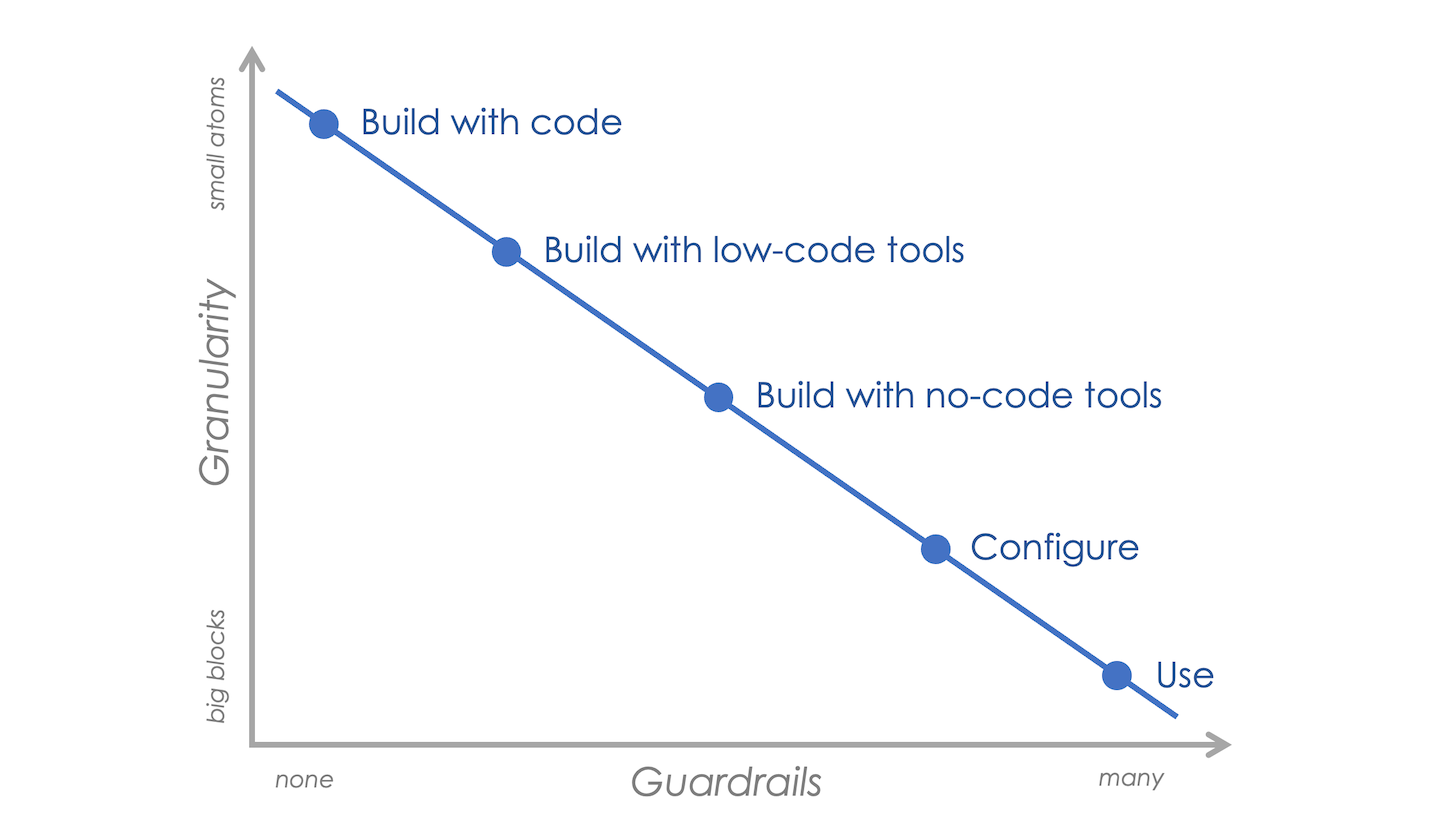
There’s been a sort of Pareto curve amongst granularity of composability (how a great deal control do you have at the most moment amount) and guardrails for composability (how constrained are you in what you can do, often for your personal excellent).
Composing with code, with a significant-diploma of granularity, has expected major technical expertise. It gave you in essence limitless flexibility in what you could establish. But all that liberty was a double-edged sword. You could very easily damage your self by unintentionally undertaking bad points. Bug town, little one.
In distinction, making use of a fundamental spreadsheet — devoid of any fancy scripting or state-of-the-art purpose phone calls — would allow you merge knowledge jointly. But you could only do the job with “small data” that match into a tabular structure that was a static snapshot in time. You could not execute workflows or build apps with it. This was substantially far more restricting than programming with code. But it was significantly, a lot safer. The guardrails of what you ended up equipped to do and not do in just a spreadsheet kept you from hurting yourself, at minimum in a specialized sense. (You could nevertheless harm your self with shoddy details evaluation offered to a skeptical CFO, but that’s different.)
Significantly of the innovation in composability about the previous 5-10 a long time has been filling in the center involving these two ends of the spectrum. Small-code platforms could create apps or workflows with a minor less versatility but safer guardrails. No-code goods even more so. Choose your most well-liked trade-off place together the curve.
Many contexts for composability in internet marketing
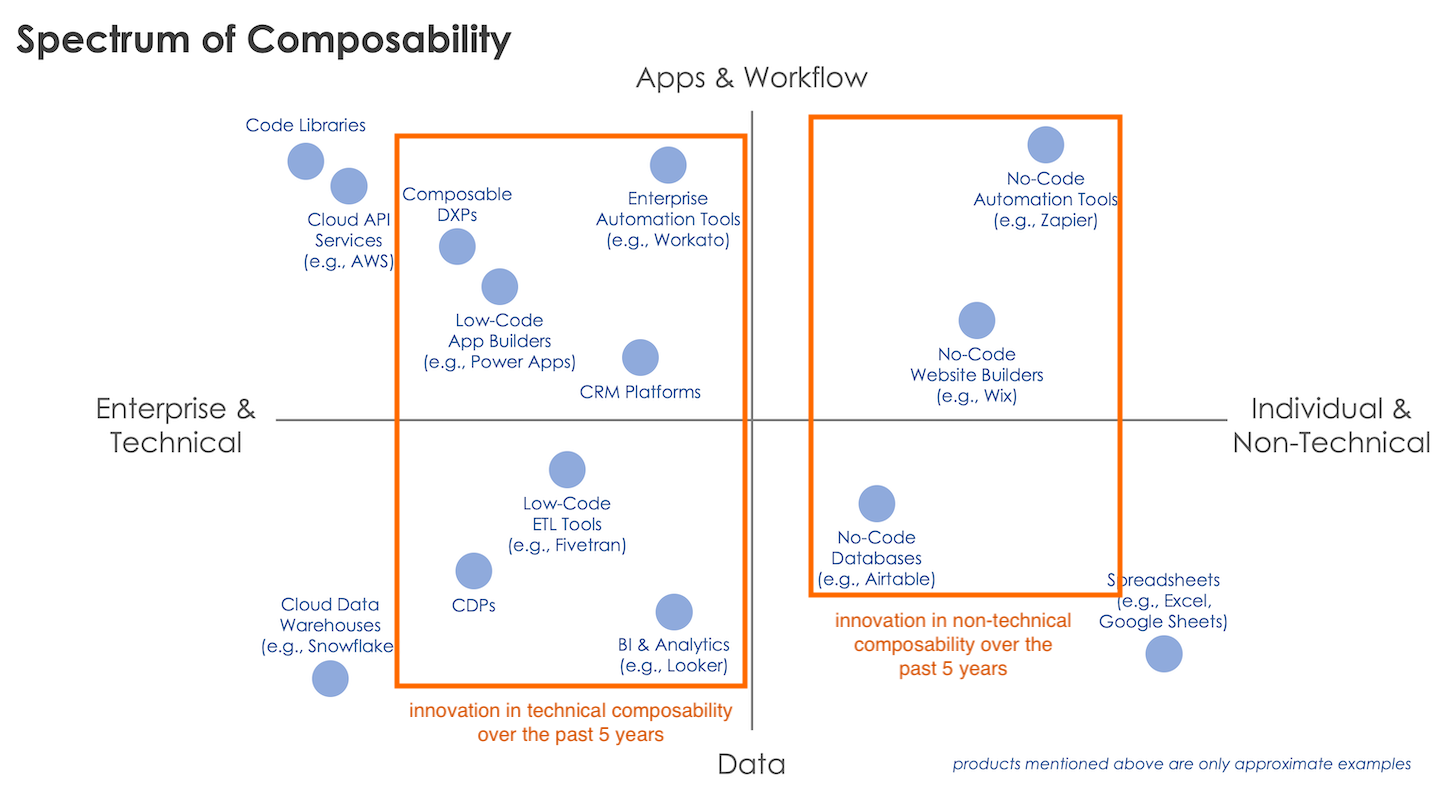
“Filling in the middle” among the dangerously-limitless and the safely and securely-constrained incarnations of composability has been a boon for marketing and martech. A ton of the innovation right here has been a end result of narrowing the context of a individual platform or device, so as to put guardrails about that context but offer a whole lot far more flexibility inside it.
Sorry, that’s a little bit summary. A couple of examples to illustrate the energy of context…
No-code web-site builders took off due to the fact they narrowed the focus to producing internet pages that experienced limited technological functionality and established layout boundaries with themes and templates. This gave non-complex entrepreneurs large independence to immediately, conveniently, cheaply publish great-searching landing web pages and microsites, with minimal-hazard of complex error.
Any content material marketer could now compose a internet web page from pre-crafted elements inside of the no-code site builder’s editor.
On the more technical aspect, CDPs have been a heck of a ton less complicated for technical entrepreneurs to function with than raw databases, since they operated inside the context of building client profiles and audience segments explicitly for internet marketing use conditions. They enabled a lot more liberty for how data could be ingested and composed into operational advertising and marketing datasets than the “closed” marketing and advertising suites that came before them. But the functions of how these data was leveraged — which could get more technically complicated — was typically downstream from the CDP by itself. This created the environment inside the CDP safer to work in, at the very least somewhat talking.
Sure, I know, you can nevertheless make problems — big mistakes — with knowledge inside of a CDP and the things you execute with that details downstream. But all those dangers are much much more managed than the open-ended, Wild West of crafting Python packages towards a generic relational databases.
Any data-savvy marketing and advertising operations qualified could now compose audiences within just a CDP, assembled from numerous resources of knowledge.
Now, the phrase “composable CDP” has come to mean a little something more distinct. Rather of possessing to copy info into your CDP to use it, composable CDPs let you use information instantly from your cloud details warehouse with out copying it. This has pros of lessening storage expenditures, info desyncs, and safety and compliance challenges. In this perception, you’re composing throughout actual physical details storage in addition to composing rational datasets.
But environment apart the specialized architecture innovation, the advantage of a composable CDP is to simply just make it more cost-effective, less difficult, and faster to compose consumer profiles and audience segments.
My point: every thing described above is composability that exists in internet marketing these days. To the degree that we don’t talk significantly about it explicitly, it’s basically a testomony to how very well this composability functions. Composability is finest when it’s nearly 2nd-mother nature in context.
So why is composability remaining talked about as anything new?
A New Generation of Composability
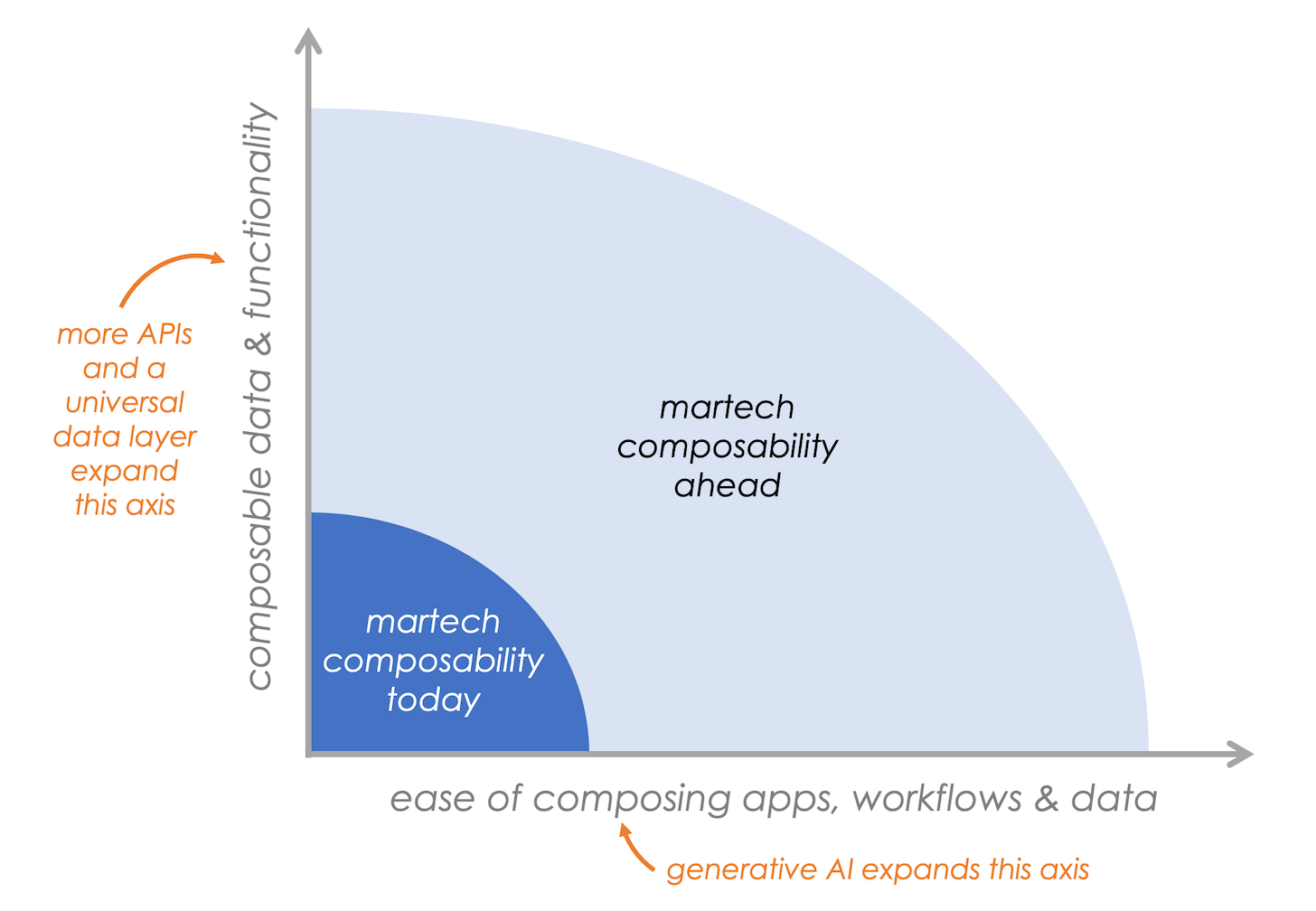
This new technology of composability is driving a substantial wave of API proliferation and the gravitational stream of a lot more facts into centralized cloud details warehouses (CDWs).
As applications expose a lot more of their functionality by using APIs — driven by the sector demand from customers for integration among applications — individuals APIs can be employed to programmatically “compose” workflows and customer activities that span various apps powering-the-scenes. As applications pipe extra facts into CDWs, it is all saved in a single common and skillfully ruled locale, where by it can much more easily be “composed” into context-distinct datasets.
iPaaS and workflow automation products and solutions, this sort of as Workato (organization) and Zapier (SMB), have prolonged taken edge of APIs to permit low-code/no-code customers orchestrate workflows throughout various apps. But as the amount of APIs grows — and as deeper features is uncovered through them — it gets doable to not merely sequence integration responsibilities in between apps, but to successfully craft your individual personalized applications with those people API products and services employed below the hood.
Here’s a metaphor: alternatively of the glue keeping the timbers of a ship jointly, the glue becomes the surface of the ship itself, with the embedded timbers serving as a body and a structural help inside. The glue is infinitely extra malleable, and allows the shipbuilder develop really differentiated ship styles.
Okay, that is an overextended metaphor. But do you get the concept?
There’s also a ton of innovation occurring in constructing much better “contexts” for composability in advertising and marketing. A single technique that has a whole lot of runway is multi-amount composability: an IT skilled may well determine sure boundaries for composability, upon which a promoting ops manager might bundle up pre-described bundles of data or features, upon which a non-specialized marketer can assemble campaigns and applications from those people all set-built elements. Every degree generates a “context” for the up coming level up.
Nevertheless, the truly remarkable detail in advance for composability is generative AI.
You understood that was coming, correct?
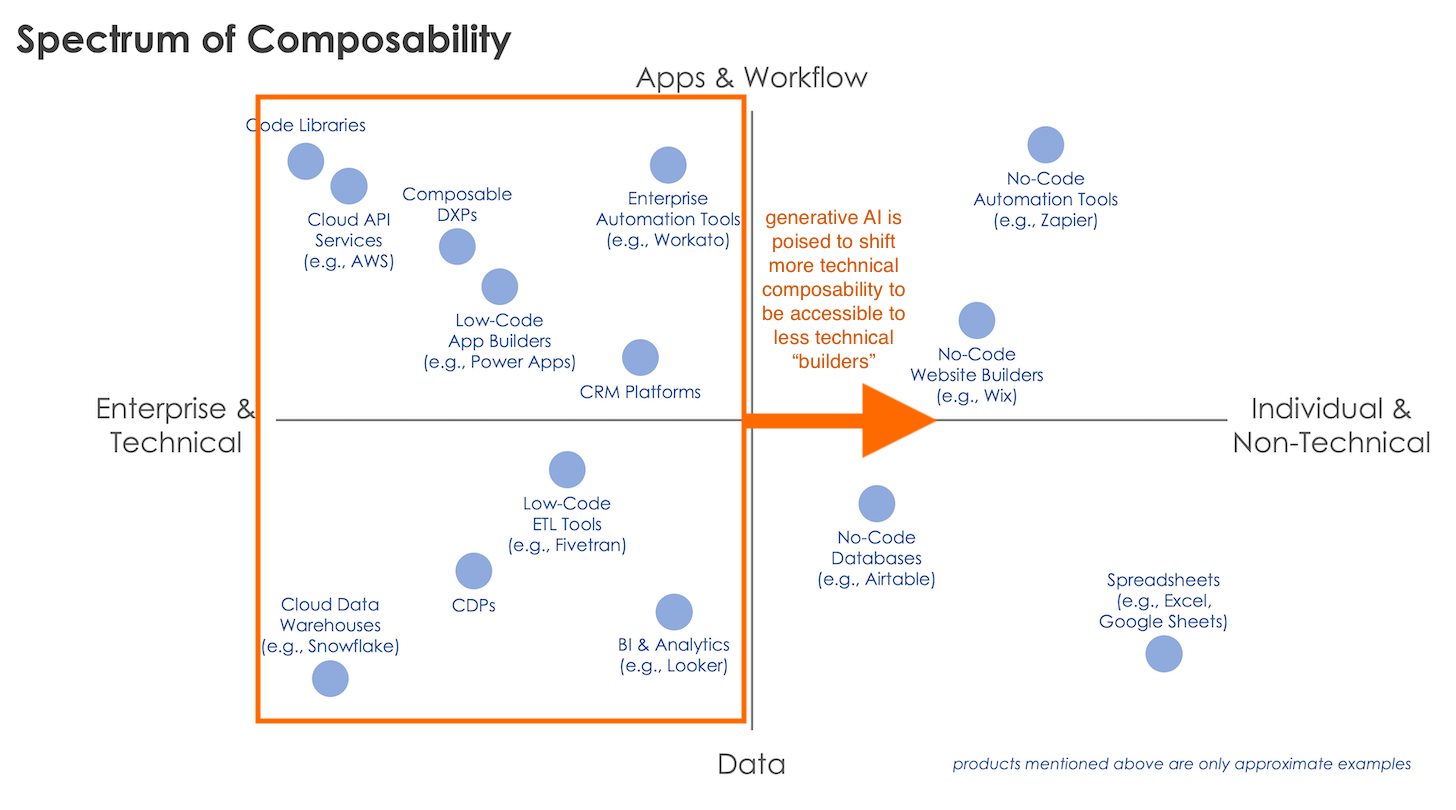
Generative AI engines will be equipped to recognize the technological mechanics of writing code, invoking APIs, and mapping across numerous facts resources on just one facet. On the other side, they’ll be ready to settle for all-natural language requests from much more non-specialized people and translate them into composed workflows and datasets.
This will efficiently change the accessibility of extra highly developed composability further more inside of attain of a lot less technical consumers. The very likely second-get outcome of this will be ever additional tailored interior electronic functions and exterior electronic buyer experiences, crafted and adapted on-demand by absolutely everyone across the promoting org.
Generative AI will be capable to push out the Pareto frontier of enabling extra versatility even though simultaneously delivering far more context-distinct guardrails due to the fact it will be in a position to have an understanding of the complete company architecture in which these requests are getting manufactured.
We’re not there however — though it’s advancing promptly.
This is why I and quite a few other people are so psyched about composability as a “new” matter these days. Composability-smart, we’re on the cusp of transitioning from rowboats to rocketships. But the core strategy of composing factors from place A to point B has been with us from the commencing.
[ad_2]
Source connection









